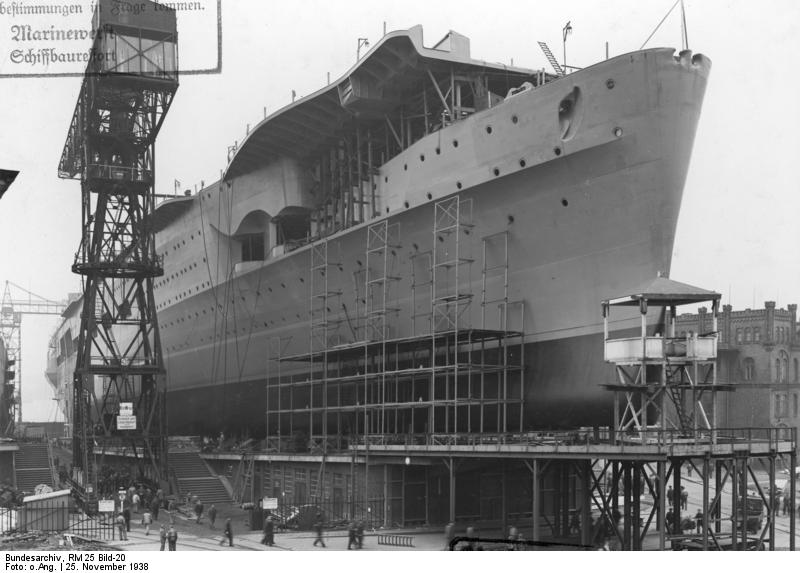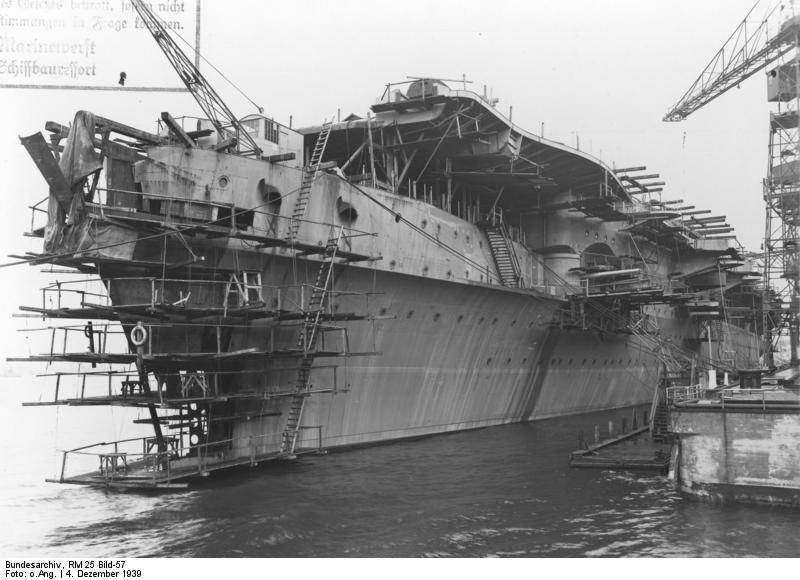The Graf Zeppelin was Nazi Germany’s only aircraft carrier, symbolizing the nation’s ambitious naval aspirations during World War II.

Although nearing completion by 1939, shifting war priorities and internal debates within the Kriegsmarine led to its construction being halted.
Captured by the Soviet Union at the war’s end, its post-war fate was sealed in 1947 when it was used for target practice and subsequently sunk in the Baltic Sea.
Historical Background
In the decades following World War I, the geopolitical landscape of the world was shifting rapidly.
The Treaty of Versailles had imposed stringent limitations on Germany’s military capabilities, especially its naval strength.
However, with the rise of the Nazi party and Adolf Hitler’s repudiation of the Treaty, Germany was determined to reclaim its status as a dominant global power.
The naval realm became a significant arena of competition, and the emerging significance of aircraft carriers in naval warfare was unmistakable.
The major powers of the world were rapidly realizing the potential of naval air power.
The British Royal Navy had already launched HMS Ark Royal, and the U.S. Navy was building carriers like the USS Enterprise.
Japan too was bolstering its naval air force, keenly aware of the strategic advantage it could provide in the Pacific.
All these developments highlighted a paradigm shift from traditional battleships to more versatile and potent aircraft carriers, which were becoming the new benchmarks of maritime dominance.
Germany, under the Third Reich, was not to be left behind. The Kriegsmarine, Germany’s navy, underwent significant expansion under Plan Z.
This ambitious plan aimed to reposition Germany as a global naval powerhouse by 1945.
The British Isles, heavily dependent on sea lanes for resources and trade, were vulnerable to naval blockades, and Germany recognized the potential of having a powerful aircraft carrier to exploit this vulnerability.
The decision to build the Graf Zeppelin was also influenced by Germany’s experiences in World War I.
The naval blockade imposed by the Allies had severely impacted the German war effort, leading to widespread hunger and discontent.
With memories of this blockade still fresh, Germany’s naval strategists understood the importance of having a balanced and modern fleet capable of both defending German waters and projecting power beyond them.
However, Germany’s naval ambitions, epitomized by the Graf Zeppelin, were not just about military strategy. They were also symbolic.
The carrier was a statement of intent, showcasing Nazi Germany’s determination to break free from the shackles of Versailles and reassert its position on the global stage.
Design Of The Graf Zeppelin
Unlike many of its contemporaries, the Graf Zeppelin boasted an armored flight deck. This design choice was a significant deviation from the convention of the era.
The British and American aircraft carriers predominantly featured wooden flight decks without substantial armor.
The rationale behind the Graf Zeppelin’s armored deck was twofold.
Firstly, it provided additional protection against aerial bombs and strafing attacks, which were becoming more potent with advancements in aviation technology.
Secondly, the armored deck signified a German anticipation of close-quarter naval engagements, where the carrier might be under threat from surface vessels and needed added protection.
The Graf Zeppelin was designed to carry a complement of 42 aircraft. These would include the Messerschmitt Bf 109T fighters and Junkers Ju 87C Stuka dive bombers.
Both aircraft models were adaptations of their land-based counterparts, re-engineered for the rigors of naval operations.
The inclusion of the Stuka dive bomber was particularly notable.
 The Graf Zeppelin under construction in 1938. Image by Bundesarchiv CC BY-SA 3.0 de
The Graf Zeppelin under construction in 1938. Image by Bundesarchiv CC BY-SA 3.0 de
Known for its iconic and terror-inducing siren, the Stuka was a symbol of German air power in the early stages of World War II.
Its inclusion in the Graf Zeppelin’s air group indicated a desire to have a powerful strike capability against both naval and land targets.
The Graf Zeppelin was not merely an airbase at sea but a battleship in its own right.
It was equipped with an array of 150 mm guns, which could serve dual purposes: bombarding surface targets and providing a last line of defense against enemy ships that got too close.
Additionally, the carrier was armed with multiple anti-aircraft guns, ensuring a 360-degree protective envelope against aerial threats.
This robust armament was a testament to Germany’s belief that its carriers would operate in contested environments and needed the firepower to both defend themselves and project power.
Beyond its armaments and flight capabilities, the Graf Zeppelin was a marvel of naval engineering.
The hangar decks, elevators, and maintenance facilities were meticulously designed to ensure rapid aircraft deployment and retrieval – crucial for maintaining a tempo of operations during combat.
The ship’s propulsion system was equally impressive, with powerful engines that provided the Graf Zeppelin with a top speed that made it competitive with other major carriers of the era.
The Strategic Dilemma
As World War II loomed large on the horizon, nations scrambled to recalibrate their military strategies and assets to better suit the changing dynamics of warfare.
The Graf Zeppelin, Germany’s ambitious foray into naval aviation, found itself at the epicenter of a profound strategic dilemma.
This conflict was not just about resources or shipbuilding capabilities; it represented a deeper uncertainty within the German High Command about the very direction of the nation’s naval future.
The Kriegsmarine, under the leadership of Grand Admiral Erich Raeder, recognized the transformative impact of aircraft carriers.
Raeder believed that for Germany to challenge the might of the Royal Navy and secure its Atlantic and Baltic ambitions, it needed a potent blend of surface raiders, U-boats, and aircraft carriers.
Conversely, Adolf Hitler’s strategic vision was more continental in nature.
His gaze was firmly fixed on the vast expanses of the Soviet Union and the resources of Eastern Europe.
This focus on land warfare, particularly the Blitzkrieg tactics that had served Germany so well in the early stages of the war, meant that naval projects, especially something as resource-intensive as the Graf Zeppelin, often found themselves relegated to the background.
 Launching of the Graf Zeppelin, 1938.
Launching of the Graf Zeppelin, 1938.
As the war unfolded, the pivotal role of aircraft carriers became unmistakably clear.
The British Royal Navy, with carriers like the Ark Royal, showcased the versatility of these vessels, from supporting amphibious invasions to hunting down battleships like the Bismarck.
The Japanese, too, with their carrier-centric strategy, underscored the potential of naval air power with the devastating attack on Pearl Harbor.
Amidst these global developments, the Graf Zeppelin project oscillated between periods of progress and neglect.
While the ship’s construction had begun with much fanfare, the lack of a consistent strategy and direction soon became evident.
The training of naval aircrews, which should have been a top priority, lagged behind. No clear doctrine was developed for integrating the carrier into broader fleet operations.
It was as if the Graf Zeppelin, for all its engineering brilliance, was a ship adrift in the tumultuous seas of German military bureaucracy and indecision.
This strategic dilemma was costly. The resources and time expended on the Graf Zeppelin could have been directed elsewhere had a clear decision been made earlier.
Moreover, had the carrier been completed and deployed with a trained air group, it could have significantly altered the naval balance in the Atlantic, posing a formidable threat to Allied convoys and naval task forces.
The Fate Of The Graf Zeppelin
As the storm clouds of war gathered, the Graf Zeppelin was approaching completion. By 1939, the ship was nearly 85% complete.
Yet, despite the impressive progress and the vast resources already poured into the project, the carrier’s journey was fraught with interruptions.
The shifting priorities of the Nazi leadership, the oscillating fortunes of war, and internal debates within the Kriegsmarine about the role of the carrier continually impacted the vessel’s construction timeline.
Even as it remained unfinished, the Graf Zeppelin was not without value to the Nazi propaganda machine.
The very existence of the carrier—massive, modern, and unmistakably German—served as a potent symbol of the Third Reich’s naval aspirations.
This sentiment was frequently echoed in Nazi propaganda materials, where the Graf Zeppelin was showcased as a testament to German technological prowess and naval resurgence.
 Work continues on the Graf Zeppelin, 1939. Image by Bundesarchiv CC BY-SA 3.0 de
Work continues on the Graf Zeppelin, 1939. Image by Bundesarchiv CC BY-SA 3.0 de
As World War II raged on, Germany’s strategic focus shifted primarily towards the Eastern Front and the colossal struggle against the Soviet Union.
Resources were increasingly diverted to this front, leading to a decline in attention and funding for many naval projects, including the Graf Zeppelin.
Moreover, the constant Allied bombing campaigns targeting German infrastructure and shipyards further hampered any consistent efforts to complete the vessel.
In the waning days of World War II, the Graf Zeppelin found itself in Stettin (now Szczecin, Poland).
Captured by advancing Soviet forces in 1945, the ship’s future became a subject of considerable speculation.
Some believed that the Soviets would complete and commission the vessel into their navy, while others felt that it would be scrapped to prevent its technology from falling into Western hands.
Ultimately, the Graf Zeppelin met a somber end. In 1947, the ship was used for target practice by the Soviet Navy and subsequently sunk in the Baltic Sea.
Today, the Graf Zeppelin lies at the bottom of the Baltic, a silent relic of a bygone era.
While its operational impact on World War II was negligible, the carrier’s legacy offers profound lessons.
It stands as a testament to the challenges of military decision-making, the importance of strategic clarity, and the often unpredictable interplay between political ambitions and wartime realities.





